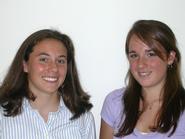
Nicole Tetreault '08 (Schenectady, N.Y.) and Amy Klockowski '09 (Rome, N.Y.) spent their summer in the lab of Silas D. Childs Professor of Chemistry Robin Kinnel working on what is affectionately known as "the butterfly project." They studied the Phyciodes tharos (pearl crescent) butterfly in conjunction with the chemical germacrene D, a natural chemical produced in plants.
Germacrene D is a naturally-occurring chemical in plants and fungi. It is also a chiral molecule which has two enantiomers (forms), a plus and a minus. Different plants produce different ratios of these two enantiomers and it has been suggested that certain insects can and do distinguish between the two kinds of germacrene D when choosing where to lay their eggs.
Tetreault and Klockowski used the Phyciodes as their insect and aster plants, naturally where Phyciodes lays its eggs, as their plant. It has been proven that Phyciodes does not use visual stimulation to choose an egg site and the butterfly project team hopes to prove that they (Phyciodes) use chemical stimulation. In other words, Tetreault and Klockowski are trying to determine whether an elevated level of the minus enantiomer influences butterfly behavior.
Tetreault took samples of three different aster species and used Chiral Gas Chromotography to analyze the plants. This process "breaks down the chemical (germacrene D) based on its chirality [molecular arrangement, and] shows peaks with different areas which can then be interpreted into ratios of the two enantiomers in the plant sample." It tells the researcher how the germacrene D varies. Tetreault also went out into the field and caught several female Phyciodes which were then put in butterfly boxes to see where they laid their eggs. The chosen leaves were then analyzed. The goal of her project, she said, was "to prove that minus germacrene D is a chemical stimulant for oviposition."
Klockowski was the one to extract the germacrene D, which she took from New England Aster and Goldenrod plants. She used chromatography to isolate the compound, after which she ran tests on it to help her understand the purity of the sample and its chiral composition.
Interviewed at the end of the summer, Klockowski was happy to report that she had succeeded in isolating the germacrene, although she was unable to fully analyze the sample because she was forced to wait for a necessary part of the polarimeter complex, the machine she uses for analysis. She was satisfied, however, that she had successfully extracted a pure sample and felt that the evidence gathered by her and Tetreault support the same conclusion.
Tetreault, a first-time summer researcher, was drawn to research partly through word-of-mouth: she had talked to summer research veterans and decided to try it herself. As a chemistry major with plans for medical school, she also wanted "more lab exposure." Her final thoughts? "It's amazing." Klockowski, an undeclared chemistry major who also became interested in the program through word-of-mouth, concurred. "I love it," she said of her first summer of research. "It's been a lot of fun…it's great to get this type of experience as an undergraduate."
Both researchers presented their results at Kinnel's CHOG conference at the end of July. They said the conference had gone well and also the project, despite some problems at the beginning (Klockowski had trouble getting a good sample because minus germacrene D tends to be at low concentrations early in the season). "It was rewarding to see a product after all your hard work," Klockowski said.
Tetreault plays soccer and lacrosse during the school year. Klockowski is active in volunteer work, a member of the Campus Activities Board, and will be an orientation leader for Orientation 2006. Both hope to return to the lab next summer.
-- Lisbeth Redfield
Posted August 21, 2006
